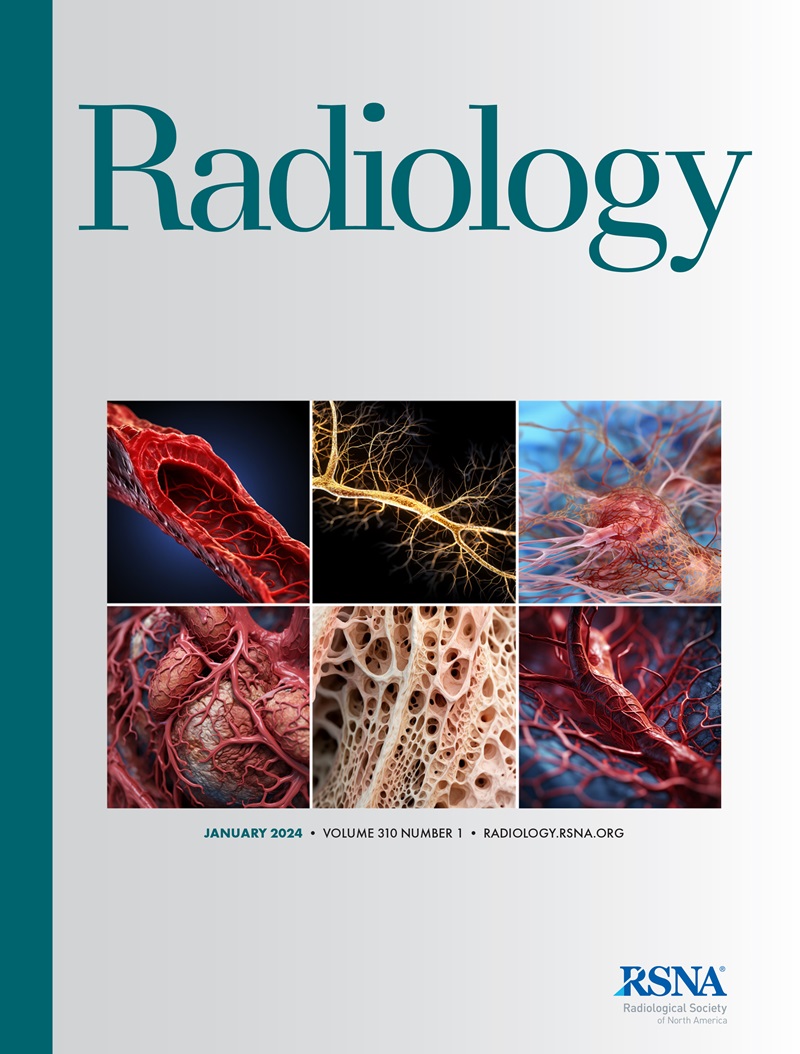Reliability of CT Enterography for Describing Fibrostenosing Crohn Disease.
Florian Rieder, Christopher Ma, Jurij Hanzel, Joel G Fletcher, Mark E Baker, Zhongya Wang, Leonardo Guizzetti, Lisa M Shackelton, Julie Rémillard, Mihir Patel, Jiafei Niu, Ronald Ottichilo, Cynthia S Santillan, Nunzia Capozzi, Stuart A Taylor, David H Bruining, Guangyong Zou, Brian G Feagan, Vipul Jairath, Jordi Rimola
下载PDF
{"title":"Reliability of CT Enterography for Describing Fibrostenosing Crohn Disease.","authors":"Florian Rieder, Christopher Ma, Jurij Hanzel, Joel G Fletcher, Mark E Baker, Zhongya Wang, Leonardo Guizzetti, Lisa M Shackelton, Julie Rémillard, Mihir Patel, Jiafei Niu, Ronald Ottichilo, Cynthia S Santillan, Nunzia Capozzi, Stuart A Taylor, David H Bruining, Guangyong Zou, Brian G Feagan, Vipul Jairath, Jordi Rimola","doi":"10.1148/radiol.233038","DOIUrl":null,"url":null,"abstract":"<p><p>Background Standardized methods to measure and describe Crohn disease strictures at CT enterography are needed to guide clinical decision making and for use in therapeutic studies. Purpose To assess the reliability of CT enterography features to describe Crohn disease strictures and their correlation with stricture severity. Materials and Methods A retrospective study was conducted in 43 adult patients with symptomatic terminal ileal Crohn disease strictures who underwent standard-of-care CT enterography at a tertiary care center at the Cleveland Clinic between January 2008 and August 2016. After training on standardized definitions, four abdominal radiologists blinded to all patient information assessed imaging features (seven continuous measurements and nine observations) of the most distal ileal stricture in two separate sessions (separated by ≥2 weeks) in random order. Features with an interrater intraclass correlation coefficient (ICC) of 0.41 or greater (ie, moderate reliability or better) were considered reliable. Univariable and multivariable linear regression analysis identified reliable features associated with a visual analog scale of overall stricture severity. Significant reliable features were assessed as components of a CT enterography-based model to quantitate stricture severity. Results Examinations in 43 patients (mean age, 52 years ± 16 [SD]; 23 female) were evaluated. Five continuous measurements and six observations demonstrated at least moderate interrater reliability (interrater ICC range, 0.42 [95% CI: 0.25, 0.57] to 0.80 [95% CI: 0.67, 0.88]). Of these, 10 were univariably associated with stricture severity, and three continuous measurements-stricture length (interrater ICC, 0.64 [95% CI: 0.42, 0.81]), maximal associated small bowel dilation (interrater ICC, 0.80 [95% CI: 0.67, 0.88]), and maximal stricture wall thickness (interrater ICC, 0.50 [95% CI: 0.34, 0.62])-were independently associated (<i>P</i> value range, <.001 to .003) with stricture severity in a multivariable model. These three measurements were used to derive a well-calibrated (optimism-adjusted calibration slope = 1.00) quantitative model of stricture severity. Conclusion Standardized CT enterography measurements and observations can reliably describe terminal ileal Crohn disease strictures. Stricture length, maximal associated small bowel dilation, and maximal stricture wall thickness are correlated with stricture severity. © RSNA, 2024 <i>Supplemental material is available for this article.</i> See also the article by Rieder et al in this issue. See also the editorial by Galgano and Summerlin in this issue.</p>","PeriodicalId":20896,"journal":{"name":"Radiology","volume":null,"pages":null},"PeriodicalIF":12.1000,"publicationDate":"2024-08-01","publicationTypes":"Journal Article","fieldsOfStudy":null,"isOpenAccess":false,"openAccessPdf":"https://www.ncbi.nlm.nih.gov/pmc/articles/PMC11366669/pdf/","citationCount":"0","resultStr":null,"platform":"Semanticscholar","paperid":null,"PeriodicalName":"Radiology","FirstCategoryId":"3","ListUrlMain":"https://doi.org/10.1148/radiol.233038","RegionNum":1,"RegionCategory":"医学","ArticlePicture":[],"TitleCN":null,"AbstractTextCN":null,"PMCID":null,"EPubDate":"","PubModel":"","JCR":"Q1","JCRName":"RADIOLOGY, NUCLEAR MEDICINE & MEDICAL IMAGING","Score":null,"Total":0}
引用次数: 0
引用
批量引用
Abstract
Background Standardized methods to measure and describe Crohn disease strictures at CT enterography are needed to guide clinical decision making and for use in therapeutic studies. Purpose To assess the reliability of CT enterography features to describe Crohn disease strictures and their correlation with stricture severity. Materials and Methods A retrospective study was conducted in 43 adult patients with symptomatic terminal ileal Crohn disease strictures who underwent standard-of-care CT enterography at a tertiary care center at the Cleveland Clinic between January 2008 and August 2016. After training on standardized definitions, four abdominal radiologists blinded to all patient information assessed imaging features (seven continuous measurements and nine observations) of the most distal ileal stricture in two separate sessions (separated by ≥2 weeks) in random order. Features with an interrater intraclass correlation coefficient (ICC) of 0.41 or greater (ie, moderate reliability or better) were considered reliable. Univariable and multivariable linear regression analysis identified reliable features associated with a visual analog scale of overall stricture severity. Significant reliable features were assessed as components of a CT enterography-based model to quantitate stricture severity. Results Examinations in 43 patients (mean age, 52 years ± 16 [SD]; 23 female) were evaluated. Five continuous measurements and six observations demonstrated at least moderate interrater reliability (interrater ICC range, 0.42 [95% CI: 0.25, 0.57] to 0.80 [95% CI: 0.67, 0.88]). Of these, 10 were univariably associated with stricture severity, and three continuous measurements-stricture length (interrater ICC, 0.64 [95% CI: 0.42, 0.81]), maximal associated small bowel dilation (interrater ICC, 0.80 [95% CI: 0.67, 0.88]), and maximal stricture wall thickness (interrater ICC, 0.50 [95% CI: 0.34, 0.62])-were independently associated (P value range, <.001 to .003) with stricture severity in a multivariable model. These three measurements were used to derive a well-calibrated (optimism-adjusted calibration slope = 1.00) quantitative model of stricture severity. Conclusion Standardized CT enterography measurements and observations can reliably describe terminal ileal Crohn disease strictures. Stricture length, maximal associated small bowel dilation, and maximal stricture wall thickness are correlated with stricture severity. © RSNA, 2024 Supplemental material is available for this article. See also the article by Rieder et al in this issue. See also the editorial by Galgano and Summerlin in this issue.
CT 肠造影术描述纤维软化性克罗恩病的可靠性。
背景 需要标准化的方法来测量和描述 CT 肠造影中的克罗恩病狭窄,以指导临床决策和用于治疗研究。目的 评估 CT 肠造影特征描述克罗恩病狭窄的可靠性及其与狭窄严重程度的相关性。材料和方法 对 2008 年 1 月至 2016 年 8 月期间在克利夫兰诊所的三级医疗中心接受标准 CT 肠造影检查的 43 名有症状回肠末端克罗恩病狭窄的成人患者进行了回顾性研究。经过标准化定义的培训后,四名对患者信息完全保密的腹部放射科医生在两个独立的时段(间隔时间≥2周)以随机顺序评估了最远端的回肠狭窄的影像特征(七次连续测量和九次观察)。评分者间类内相关系数 (ICC) 达到或超过 0.41(即中等或更好的可靠性)的特征被认为是可靠的。单变量和多变量线性回归分析确定了与总体狭窄严重程度视觉模拟量表相关的可靠特征。重要的可靠特征被评估为基于 CT 肠造影模型的组成部分,以量化狭窄严重程度。结果 评估了 43 名患者(平均年龄 52 岁 ± 16 [SD];23 名女性)的检查结果。五项连续测量和六项观察结果显示了至少中等程度的检查者间可靠性(检查者间 ICC 范围为 0.42 [95% CI:0.25, 0.57] 至 0.80 [95% CI:0.67, 0.88])。其中,10 项与狭窄严重程度单变量相关,3 项连续测量--狭窄长度(评定者间 ICC,0.64 [95% CI:0.42, 0.81])、最大相关小肠扩张(评定者间 ICC,0.80 [95% CI:0.67, 0.88])和最大狭窄壁厚度(评定者间 ICC,0.50 [95% CI:0.34, 0.62])--独立相关(P 值范围,本文有补充材料。另请参阅本期 Rieder 等人的文章。另请参阅本期 Galgano 和 Summerlin 的社论。
本文章由计算机程序翻译,如有差异,请以英文原文为准。


